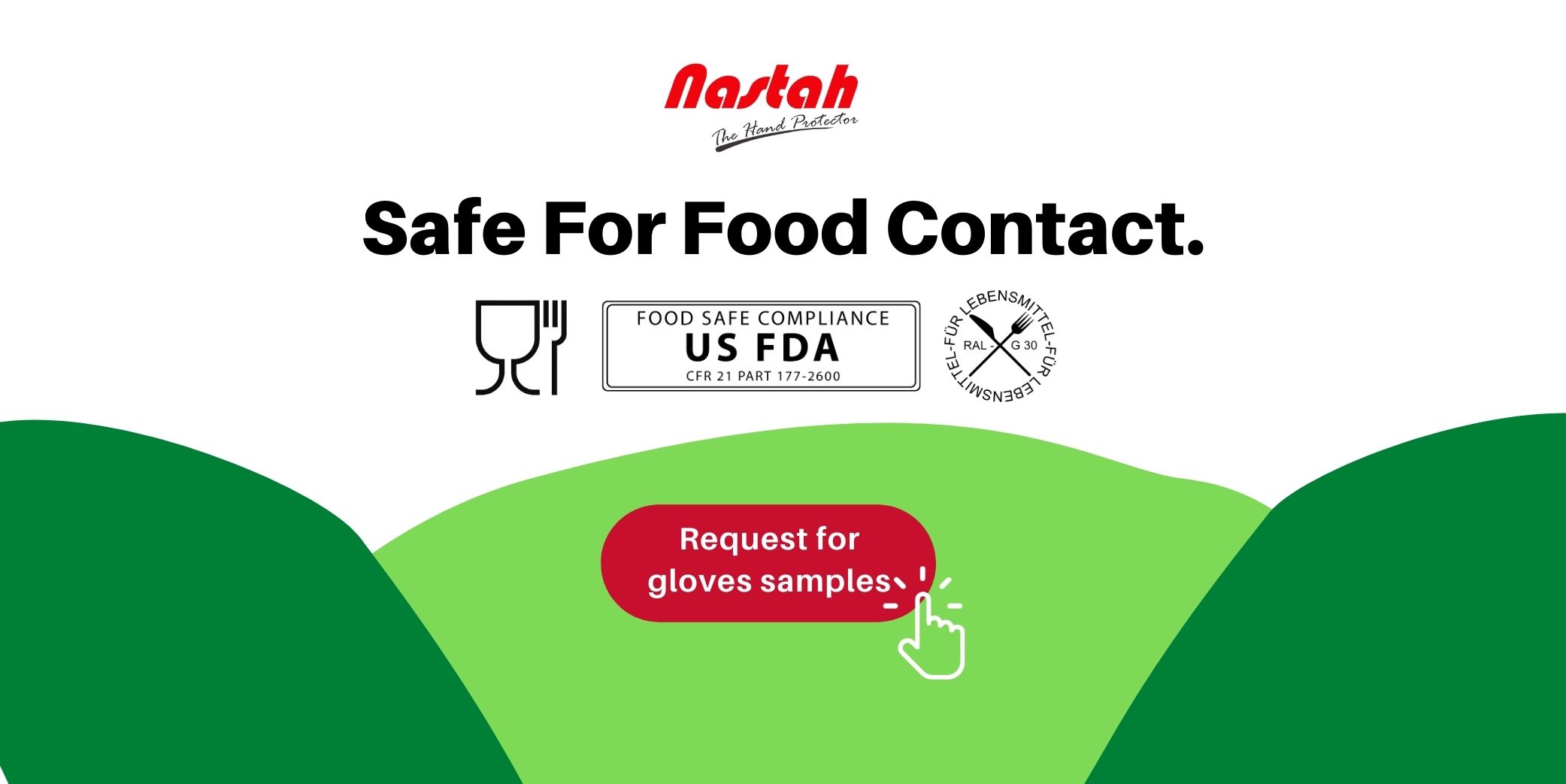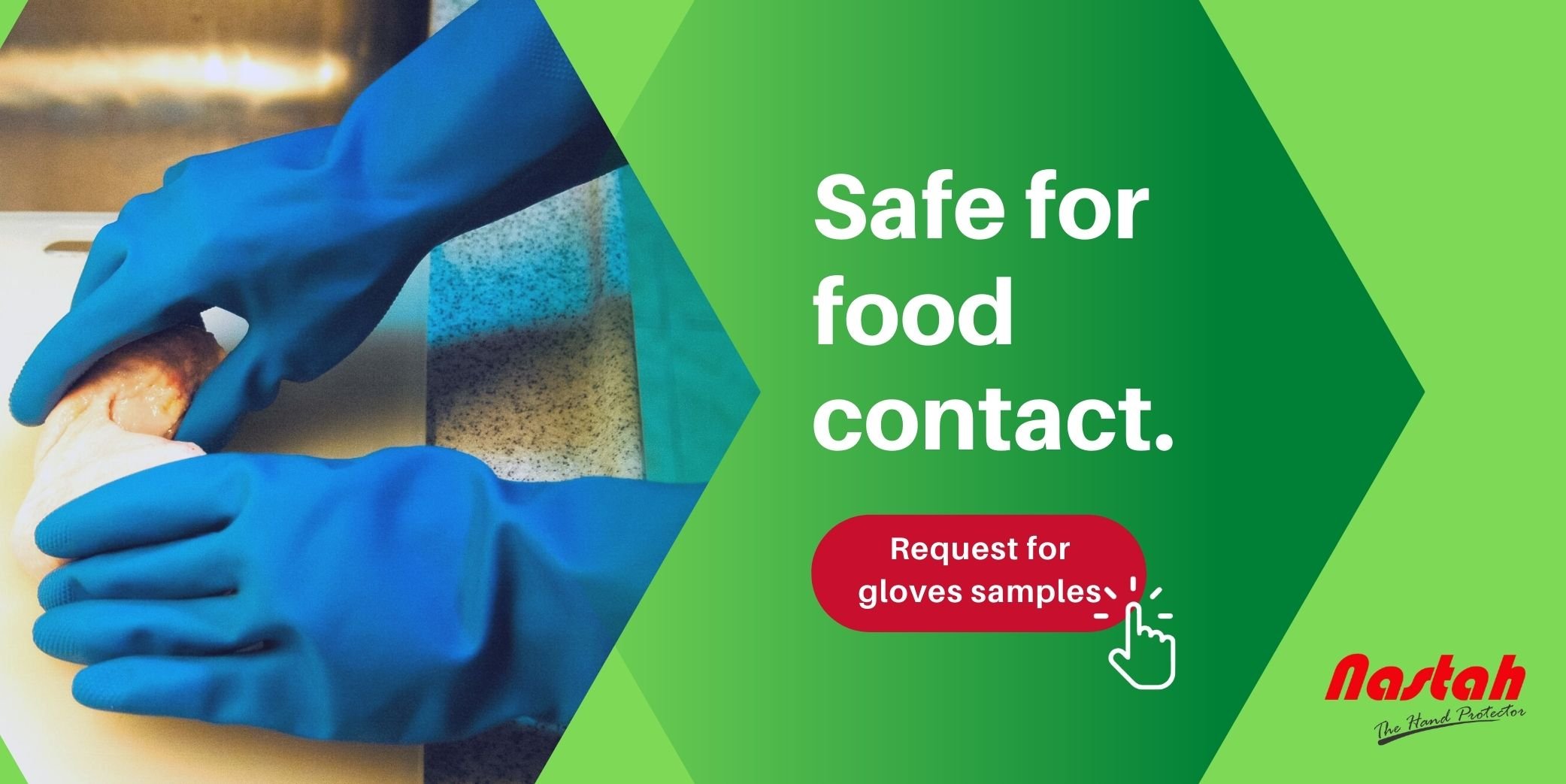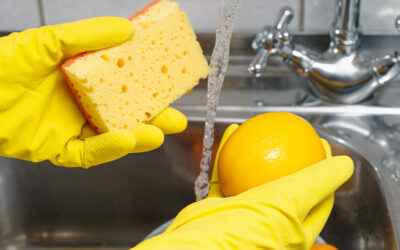When it comes to food handling, it is important to keep in mind that good food safety practices are always the priority.
Be it in the food processing industry that handle poultry, or in the food service industry that turn raw food into ready-to-eat food, protecting food from bacterial and viral transfer from a gloved hand is essential.
Gloves play a major role as PPE to enhance your food safety programs to prevent food-borne illnesses. Hence, it is essential for business owners and safety officer to understand the criteria when choosing gloves for food handling purpose.
However, there is one thing that we as a rubber gloves manufacturer would want to clarify when we talk about safety gloves for food handling.
We usually see people wearing disposable gloves when handling food, be it at the bakeries, hawker stalls or even restaurant kitchens. But, do you know that reusable rubber gloves that comply to certain regulations are safe for food handling as well?
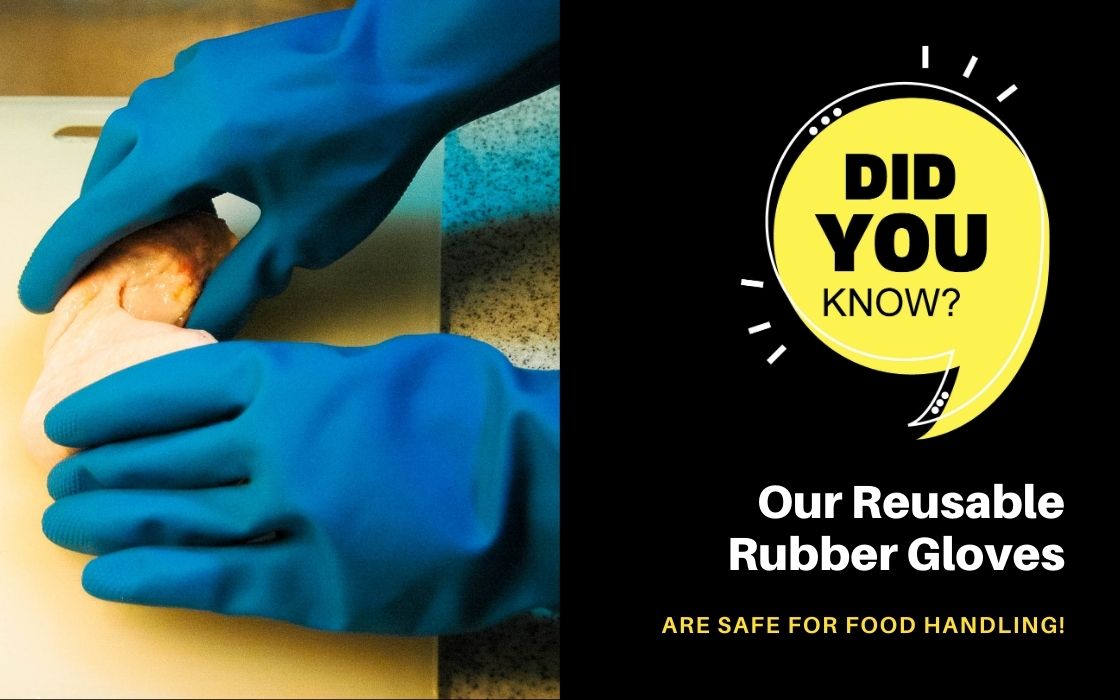
Especially in such difficult disposable glove market right now, where the demand for disposable gloves has consequently gone through the roof, it is time to start looking for alternatives.
Alternatives do not mean that you need to compromise with the quality or the price. In fact, if you have enough understandings about the alternatives, you will be very confident in making your sourcing decision.
Just like the food safety gloves topic that we are going to discuss today, there are so many factors that can affect the choice of gloves that you want to bring into your market or even your business.
In this blog post, we will be discussing 7 criteria to look at when choosing gloves for food handling:
# 1: Food safety related markings & regulations
# 2: Gloves materials
# 3: Gloves lining
# 4: Grip pattern on gloves
# 5: Gloves size/ fitting
# 6: Gloves thickness
# 7: Gloves color
Let us go through all these criteria together!
#1 : Food safety related markings & regulations
We will separate this section into 2 parts, which includes:
#1.1 Glass and Fork Symbol
#1.2 FDA CFR 21 Part 177-2600 – Rubber articles intended for repeated use
#1.1 Glass and Fork symbol
Gloves must comply to regulation to make sure it is safe.
Within the European Union, all food contact materials and articles that intended to come into contact with food need to comply with the EC Regulation No. 1935/2004. In this article, the food contact material will be gloves.
The EC Regulation No. 1935/2004 states that:
- Food contact materials must not transfer their components into food in quantities that could endanger human health, change food composition in an unacceptable way or deteriorate its taste and odour.
- Food contact materials must be traceable throughout the production chain.
- Materials and articles, which are intended for food contact must be labelled with the words ‘for food contact’, or a specific indication as to their use or use the glass and fork symbol as below:

If you are looking for gloves to handle food, take a closer look at the gloves manufacturer website or gloves packaging and spot for this symbol. Gloves with this symbol mean that the gloves are safe for food handling since it complies with EC Regulation No. 1935/2004 for food contact application.
All of our products are in compliance with EC Regulation No.1935/2004 for food contact applications.
#1.2 FDA CFR 21 Part 177-2600 – Rubber articles intended for repeated use
To ensure gloves will not transfer harmful chemicals, colors, odors or tastes to food, they must comply with FDA 21 CFR Part 177.2600– Rubber articles intended for repeated use.
Rubber articles intended for repeated use may be safely used in producing, manufacturing, packing, processing, preparing, treating, packaging, transporting, or holding food, subject to the provisions of this section.
This Code of Federal Regulations (CFR) lists the permitted materials and chemicals that can come into contact with food.
This includes the elastomers, such as acrylonitrile-butadiene copolymer (nitrile,) chloroprene polymers, and natural rubber (latex.) It also details acceptable accelerants, activators, antioxidants, plasticizers, fillers, and colorants used in manufacturing these rubber articles.
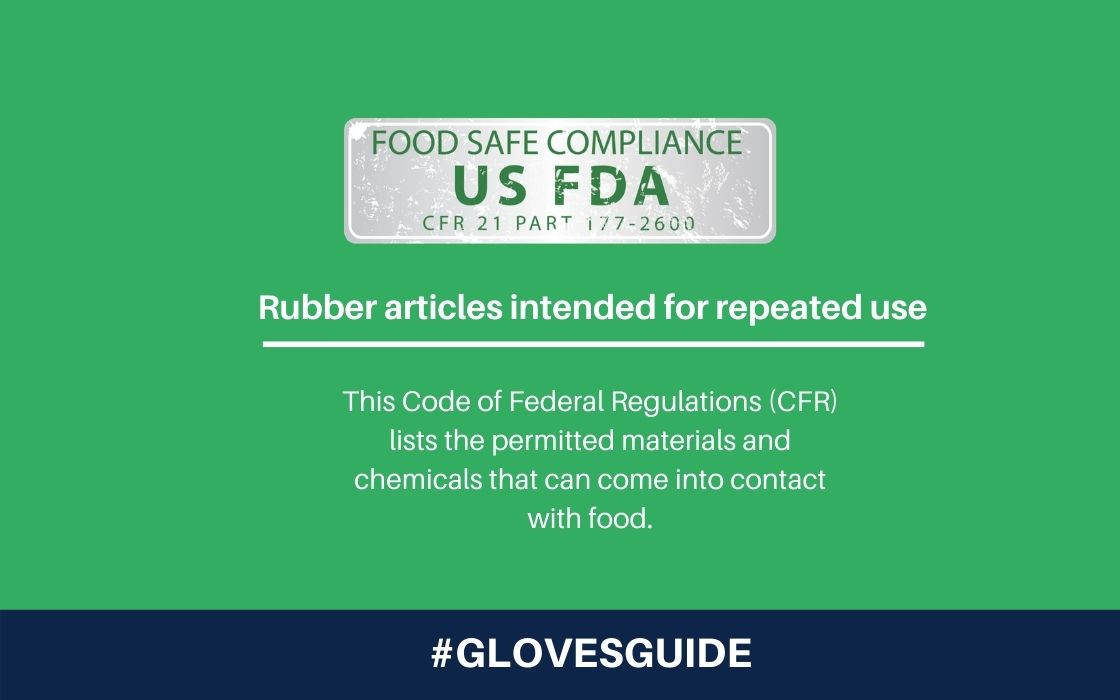
Please visit this website for more details about the permitted materials and chemicals:
With so many gloves types on the market – considering their differences in materials, thickness, internal and external treatments – it is important to determine if your selected glove is suitable for food contact.
Kindly take note that all of our gloves products comply with US FDA CFR 21 Part 177.2600 for food contact application.
#2: Gloves materials
Should I choose natural rubber gloves or nitrile gloves for food handling?
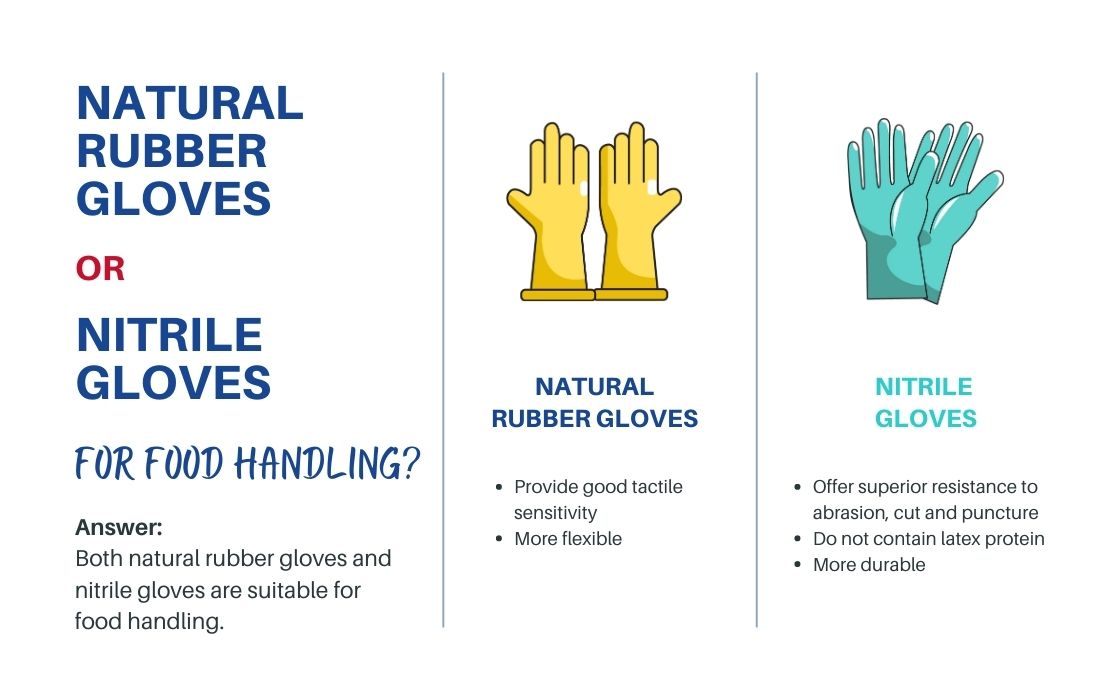
Both natural rubber gloves and nitrile gloves are suitable for food handling.
While natural rubber gloves are more flexible and provide good tactile sensitivity, nitrile gloves offer superior resistance to abrasion, cut and puncture compared with natural rubber gloves.
In addition, nitrile gloves do not contain latex protein in the glove, which eliminate the chance of developing Type I latex allergy.
However, if you are looking for more flexibility over durability, you may want to go for natural rubber gloves instead.
#3: Gloves lining
Should I choose unlined or flocklined gloves for food handling?
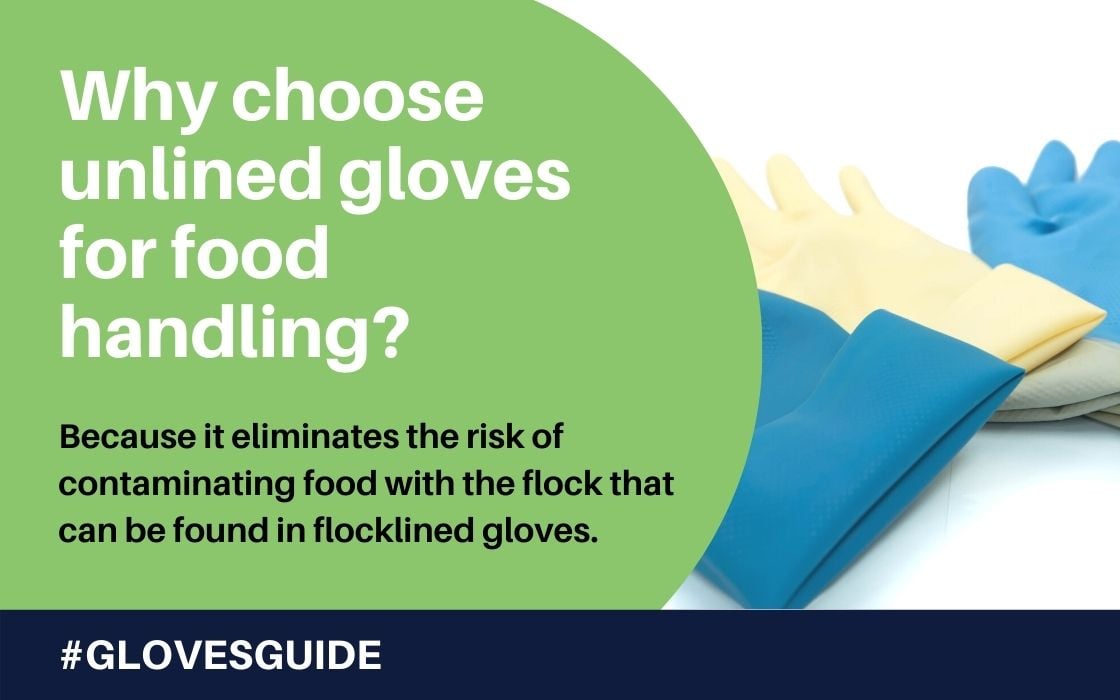
Unlined gloves will be suitable for food handling.
While flocklined gloves are great in absorbing perspiration, unlined gloves are chlorinated for easy donning.
In addition, without lining in the gloves, it eliminates the risk of contaminating food with the flock that can be found in flocklined gloves.
#4: Grip pattern on gloves

Grip are especially important when it comes to food handling.
Imagine the fish or potatoes on your hands just slip away in the next seconds even you have your gloves on. Totally unacceptable, right?
Applications that involve handling poultry, seafood, raw potatoes, and other vegetables with slippery surfaces and some red meat products may require a glove with a raised pattern, textured or embossed surface to promote a better grip.
We have specially designed raised diamond patterns on the palm and fingers of our natural rubber gloves and recessed diamond pattern on our nitrile gloves to provide excellent grip in both wet and dry conditions.
# 5: Gloves size/ fitting
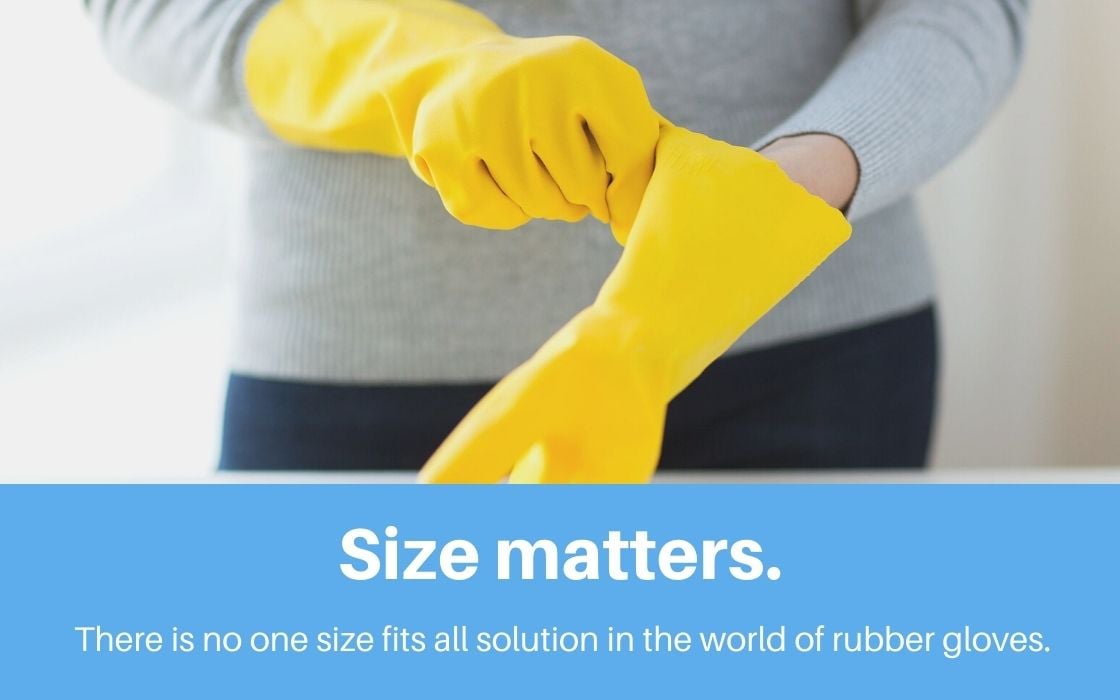
A properly fitting glove is vital in maximizing protection as well as comfort while wearing the gloves.
In the food processing industry, hygiene is the main concern, that is why it is unavoidable that workers in the industry are required to put on their gloves for long hours.
If the gloves are one size bigger or one size smaller, it might cause hands fatigue and inefficiency, end up affecting the job output.
Because we understand that unfit gloves are totally intolerable, that is why we have designed our natural rubber gloves in 4 different sizes and nitrile gloves in 5 different sizes to cater the needs of adult hands.
In the world of rubber gloves, there is no one size fits all solution.
We have previously published a post about how to choose your gloves size in just 3 steps, take a look and you will get the idea on how to measure the hands size.
# 6: Gloves thickness
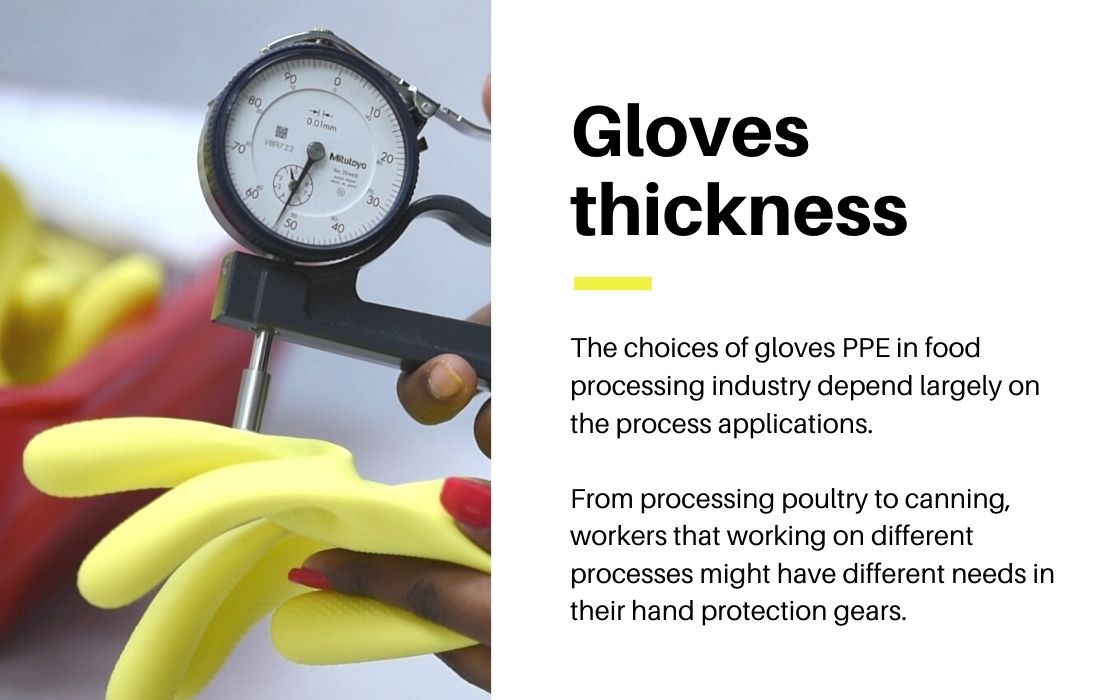
Why should we consider the thickness of the gloves when choosing gloves for food handling?
Let us pause for a second and imagine the situation in a food processing industry:
Workers are using their hands to process the aloe vera plants with thorns; they are working on the food canning process which might pose a risk of getting injured by the sharp edges of the cans; or even processing crabs that come with thick shell and sharp claws.
What do you think? Would you consider thicker gloves for such applications?
Don’t get us wrong. We are not saying that thicker gloves are definitely better.
We just want to point out the fact that the choices of gloves PPE in food processing industry depend largely on the process applications. From processing poultry to canning, workers that working on different processes might have different needs in their hand protection gears.
It is advisable to get your workers involve and get them to try on some gloves samples before switching.
Please do not hesitate to get in touch with our gloves expert for food processing gloves recommendations.
# 7: Gloves color
Have you ever wondered why most of the gloves that are being used to handle food are in blue color? Especially those gloves that are being used in the food processing industry that are handling poultry, such as chickens, turkeys, ducks etc.
The reason is that:
Blue is a color that contrasts sharply with poultry. If a rubber glove is accidentally torn during the process, it will be easier to detect the torn pieces of the glove.

What if other color such as natural color gloves are being used in the food processing process? In fact the gloves will still work great for the job, but try to imagine this situation:
A worker in the food processing plant is wearing a pair of natural color rubber gloves to process chickens. Out of a sudden the rubber gloves were just torn into pieces. Do you see the problem here?
The problem is that the color of the gloves is very similar to the poultry. It will be very hard for the workers to detect the torn pieces of gloves.
And it is definitely a bad experience if the torn gloves pieces are accidentally being transferred along the food processing process and end up in the hands or mouths of end customers.
So, if you are sourcing for gloves intended for food processing purpose, it would be great to share more information about the process that the gloves are going to handle with the gloves manufacturer.
It is not merely about the choice of gloves color, but more importantly it is about the gloves users, the process owners and also the end customers.
Wondering what sort of colors we have in house?
Recap
Food safety is always a big issue as it is directly affecting the public health. That is why we place immense effort in making sure that our gloves are safe for food contact application.
Next time if you are looking for food safety gloves, remember these few points:
1.1 Look for the Glass and Fork symbol which symbolize that the gloves are safe for food handling since it complies with EC Regulation No. 1935/2004 for food contact application.
1.2 Look for gloves that comply with FDA 21 CFR Part 177.2600– Rubber articles intended for repeated use. This Code of Federal Regulations (CFR) lists the permitted materials and chemicals that can come into contact with food.
- Both natural rubber gloves and nitrile gloves are suitable for food handling. It depends on your process, if you are looking for more flexibility over durability, then you might consider opt for natural rubber gloves.
- Unlined gloves will be suitable for food handling. It eliminates the risk of having loose flock dropping into the food.
- Grip on the gloves are essential to provide excellent grip on both wet and dry conditions.
- There are no gloves that can fulfil the one size fits all solution, it is always important to get gloves that not only fit your needs, but also fit your hands.
- Thicker gloves are always better? Not necessary! It still goes back to the needs of the applications, over protection or under protection is not something that we want to achieve. Get your workers to involve and get them to try on some gloves samples before switching.
- Always choose gloves color that contrast sharply to poultry. Nobody wish to have a piece of torn glove landing on their hands or in their mouths.
I hope you have learned something in this blog post. Feel free to drop us questions in the comments below if you have any questions about this topic.
Get in touch with us if you’re interested in learning more about what we have to offer or would like some professional advice from one of our experts.
If you’re interested in reading more articles like this, subscribe to our blog and follow our Linkedin page for the latest updates, or comment below to share your thoughts with us on this blog post.


